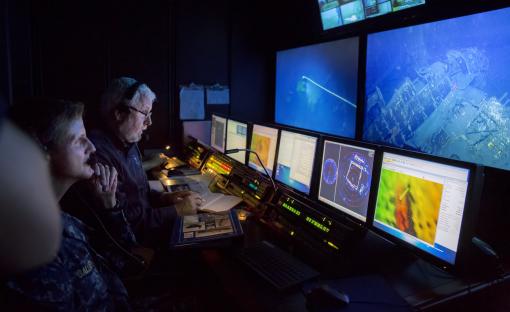Exploring Our Past and Forging Our Future

Originally posted to The Sextant, Naval History and Heritage Command's blog
By Rear Adm. Tim Gallaudet, USN
As I watched the video screen from the remotely operated vehicle (ROV) a half a mile below the ocean, the stern of the World War II light aircraft carrier USS Independence (CVL 22) came sharply into view. It triggered a memory of the opening scene of the film Titanic, where another vehicle comes upon the bow of that tragic vessel, evoking powerful emotions of a storied past and unthinkable fate. This was a surreal moment for me, not only because I was watching live scenes of the deep seafloor that looked similar to the movie, but because I was standing side by side with the discoverer of the RMS Titanic, the famed undersea explorer Dr. Robert Ballard.
As I write, we are still diving on the wreck, with two vehicles named Hercules and Argus, tethered to the Exploration Vessel (E/V) Nautilus owned and operated by Dr. Ballard's Ocean Exploration Trust. Ballard has participated in or led 149 expeditions like this one over the past five decades. Many of these were in support of the U.S. Navy, so the current expedition was nothing new for the former Massachusetts Institute of Technology/Woods Hole Oceanographic Institution professor.
The current expedition is the first to ever image the heroic Independence. She was scuttled about 30 miles south of San Francisco in 1951, after surviving two atomic bomb tests in Bikini Atoll in 1946, and before that combat action in some of the most defining sea battles for the U.S. Navy in the Pacific: Tarawa, Okinawa, and Leyte Gulf. A heart-stopping wave of pride surged over me as we saw live video of an F6F Hellcat aircraft within the carrier's hangar bay. My father flew A-3 Skywarriors off Southeast Asia from the aircraft carrier USS Bonhomme Richard (CV 31) a decade after World War II. I served aboard USS Kitty Hawk (CV 63) when we conducted the initial strikes into Afghanistan after 9/11 and in the Arabian Gulf during the initial phase of Operation Iraqi Freedom. The long thread of U.S. Navy aircraft carrier service in defense of our nation is woven into my sense of duty, so I was thrilled to join this expedition and report about it for the Naval History and Heritage Command.

I had another realization as I watched the live video (also streamed live on the internet at nautiluslive.org) of the vehicle from within Independence 's hangar bay: Dr. Ballard's team of pilots and technicians are akin to our top World War II fighter aces in terms of skill, competence, and expertise. Plus, they excel in the use of the world's most advanced undersea exploration, mapping, and research technologies.
This is my main reason for being on the Nautilus. As Oceanographer of the Navy, I oversee all Navy oceanographic, meteorological, and hydrographic capabilities, including six oceanographic survey ships. My teams use many technologies similar to Dr. Ballard's, and we are always pushing to improve. The U.S. Navy's undersea warfare capabilities, used by surface ships, aircraft, and submarines to detect, track, and, if necessary, destroy adversary submarines and mines, cannot operate effectively without detailed knowledge of the ocean's seafloor, water column, and surface. Similar to the concept of the advantage provided by occupying high ground in land warfare, my ships and Sailor-civilian teams provide our Navy's undersea warfare Commanders the "ocean high ground ". Partnerships, such as this collaboration through the Office of Naval Research, ensure that now, and in the future, the U.S. Navy's ocean high ground information is superior to our competitors. As I type these last words, the Hercules and Argus are capturing the final images of Independence for this cruise. It's been incredibly exciting to see this proud Navy ship for the first time in 65 years. It is even more exciting to chart the course for the future of the Navy's oceanographic capabilities.

Greater Farallones National Marine Sanctuary
Nautilus will return northward along the California coastline for a cruise to study the cultural heritage and natural wildlife in the Greater Farallones National Marine Sanctuary (GFNMS). Recently expanded to protect 3,295 square miles, GFNMS contains over 400 shipwrecks and is largely unexplored in the deepest portions.



